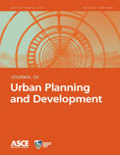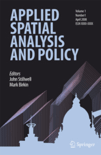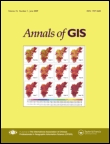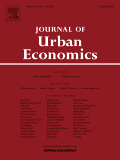
ACM Transactions on Spatial Algorithms and Systems
Scope & Guideline
Advancing the Frontiers of Spatial Algorithms.
Introduction
Aims and Scopes
- Spatial Data Processing and Analysis:
Research in this area involves the development of algorithms and methodologies for processing and analyzing spatial data, including dynamic community interactions and geospatial data structures. - Urban Analytics and Planning:
The journal emphasizes studies that leverage spatial algorithms for urban planning, including predictive modeling of urban environments and automated city configuration. - Mobility and Transportation Systems:
A significant focus is on algorithms that address mobility patterns, routing, and transportation logistics, particularly in dynamic and complex environments. - Machine Learning in Spatial Contexts:
The integration of machine learning techniques with spatial data analysis is a core theme, with applications ranging from crime prediction to traffic forecasting. - Epidemic Modeling and Public Health:
The journal has a strong emphasis on spatial algorithms applied to public health challenges, particularly in modeling and analyzing the spread of diseases. - Geospatial Data Privacy and Security:
Research addressing privacy concerns in spatial data handling and the development of secure algorithms for sensitive geographic information.
Trending and Emerging
- Spatio-temporal Data Analysis:
Recent publications indicate a growing interest in spatio-temporal analysis, with algorithms designed to handle the complexities of time-varying spatial phenomena. - Machine Learning and AI Integration:
There is a marked increase in studies that apply machine learning and AI techniques to spatial data, particularly in predictive modeling and pattern recognition within urban and environmental contexts. - Real-time and Dynamic Systems:
Research focusing on real-time data processing and dynamic systems is trending, addressing the need for algorithms that can adapt to rapidly changing spatial information. - Applications in Public Health and Epidemic Response:
The COVID-19 pandemic has catalyzed a surge in research applying spatial algorithms to public health issues, particularly in modeling disease spread and evaluating containment measures. - Drone and UAV Applications:
There is a rising trend in the use of drones and unmanned aerial vehicles (UAVs) for spatial monitoring and data collection, showcasing the integration of spatial algorithms in these technologies.
Declining or Waning
- Traditional Geospatial Query Optimization:
There has been a noticeable reduction in papers focusing purely on traditional geospatial query optimization techniques, as the field has shifted towards more dynamic and real-time data processing solutions. - Static Spatial Data Structures:
Research on static spatial data structures appears to be waning, as there is increasing interest in adaptive and scalable structures that can handle real-time changes in spatial data. - Basic Geostatistical Methods:
The prevalence of basic geostatistical methods has decreased, with a move towards more complex and integrated approaches that combine multiple data sources and advanced computational techniques. - Simple Visualization Techniques:
There is less emphasis on basic visualization techniques for spatial data, as researchers seek more sophisticated methods that incorporate interactivity and user engagement.
Similar Journals

Spatial Information Research
Advancing the frontiers of spatial data science.Spatial Information Research, published by SPRINGER SINGAPORE PTE LTD, is a prominent journal committed to advancing the interdisciplinary field of spatial information science. With an ISSN of 2366-3286 and an E-ISSN of 2366-3294, this journal serves as a crucial platform for disseminating research findings from 2016 to 2024, focusing on applications in Artificial Intelligence, Computer Science Applications, and Geography, among others. Ranking in the Q2 and Q3 quartiles across various categories, it showcases impactful research that informs geographic planning, environmental sciences, and computational methodologies. The journal's rigorous peer-review process ensures high-quality contributions that offer insights for both academic scholars and industry professionals. While retaining exclusive access options, Spatial Information Research is a vital resource for researchers eager to explore the complexities of spatial data and its applications in real-world scenarios.

GEOINFORMATICA
Advancing the Frontiers of GeoinformaticsGEOINFORMATICA is a leading journal in the field of geoinformatics, widely recognized for its contributions to both Geography, Planning and Development as well as Information Systems. Published by Springer, this journal holds a distinguished Q1 ranking in Geography and a Q2 ranking in Information Systems as of 2023, reflecting its high-impact research contributions and authoritative voice in these disciplines. Since its inception in 1997, GEOINFORMATICA has provided a platform for innovative research, methodologies, and applications related to geographic information science, spatial data analysis, and remote sensing technologies. The journal's rigorous peer-review process and strategic positioning within the academic landscape allow it to attract a diverse array of publications, assisting researchers, professionals, and students in understanding complex spatial phenomena. While the journal does not offer Open Access, it remains a vital resource located in the Netherlands, and its indexed status has secured impressive Scopus rankings—#131 in Geography, Planning and Development, and #134 in Information Systems, showcasing its robust scholarly influence. Explore the latest developments and cutting-edge research through GEOINFORMATICA, where scholarly excellence converges with real-world relevance.

JOURNAL OF URBAN PLANNING AND DEVELOPMENT
Innovating Solutions for Sustainable Urban Development.The JOURNAL OF URBAN PLANNING AND DEVELOPMENT, published by the ASCE-AMER SOC CIVIL ENGINEERS, stands as a pivotal platform in the realms of urban studies, civil and structural engineering, and development. With an ISSN of 0733-9488 and E-ISSN of 1943-5444, this journal aims to disseminate high-quality research addressing critical urban planning challenges, fostering innovative solutions, and contributing to sustainable development practices. Spanning from its inception in 1979 to the anticipated issues up to 2024, the journal proudly occupies the Q2 category across multiple disciplines, including Civil and Structural Engineering, Development, Geography, Planning and Development, and Urban Studies. Its noteworthy Scopus rankings reflect its influence, notably being positioned in the 76th percentile in Urban Studies. With no open access options currently available, the journal remains a selective forum for scholarly discourse, attracting researchers, professionals, and students eager to engage with cutting-edge developments in urban planning and design.

Applied Spatial Analysis and Policy
Advancing spatial insights for impactful policy.Applied Spatial Analysis and Policy, published by Springer, is a leading journal dedicated to advancing knowledge in the field of spatial analysis and its application in policy-making. With an ISSN of 1874-463X and an E-ISSN of 1874-4621, this peer-reviewed journal has been at the forefront of geographical research since its inception in 2009 and continues to thrive with a convergence extending to 2024. As a recognized publication in the Geography, Planning and Development category, it holds a commendable Q2 quartile ranking for 2023 and is positioned at rank #238 out of 821 in the Scopus classification, reflecting its strong impact and relevance within the academic community with a percentile of 71. The journal provides a robust platform for researchers and professionals to explore innovative methodologies and empirical studies that enrich spatial policy frameworks. While access to individual articles is not open access, its significant contribution to the field makes it a vital resource for anyone involved in spatial analysis and related disciplines.

South African Journal of Geomatics
Connecting Scholars and Professionals in GeomaticsSouth African Journal of Geomatics is a pivotal platform dedicated to the advancement of geomatics, focusing on the dynamic intersection of geographic information science, surveying, and mapping technologies. Published by CONSAS CONFERENCE, the journal serves as a crucial resource for researchers, professionals, and students in the geomatics field, providing insightful, peer-reviewed articles that explore contemporary challenges and innovations. Operating under an open-access model, the journal ensures the wide dissemination of knowledge, promoting collaboration and scholarly exchange among the global geomatics community. With a commitment to enhancing the visibility of significant research and fostering academic discourse, the South African Journal of Geomatics plays a vital role in contributing to the development of this essential discipline in South Africa and beyond.

Annals of GIS
Transforming Data into Actionable InsightsWelcome to the Annals of GIS, a leading academic journal published by Taylor & Francis Ltd, dedicated to advancing the field of Geographic Information Science and its applications. With an ISSN of 1947-5683 and an E-ISSN of 1947-5691, this Open Access journal has been ensuring wide accessibility since 2019, thereby bolstering the dissemination of knowledge in areas such as remote sensing, spatial analysis, and geoinformatics. Hailing from the United Kingdom, the journal ranks impressively within its categories, achieving a Q2 status in Computer Science Applications and a prestigious Q1 ranking in Earth and Planetary Sciences for 2023, placing it in the top 10% among its peers. With a focus on innovative research spanning from 2009 to 2024, the Annals of GIS serves as a vital platform for researchers, professionals, and students alike, providing insights and fostering discussions that push the boundaries of geographic technologies and their real-world applications.

JOURNAL OF URBAN ECONOMICS
Navigating Urban Challenges with Economic ExpertiseJOURNAL OF URBAN ECONOMICS, published by Academic Press Inc Elsevier Science, stands as a leading academic publication within the fields of Economics and Urban Studies, boasting an impressive impact factor indicative of its relevance and authority. This esteemed journal, accessible through traditional subscription channels, has been pivotal since its inception in 1974, offering a platform for comprehensive research that integrates economic theory with urban policy analysis. With a distinguished ranking of Q1 in both its categories for 2023, it ranks in the top 96th percentile for Urban Studies and the top 93rd percentile for Economics and Econometrics in Scopus, underscoring its significance and impact within the academic community. As the urban landscape continues to evolve, the JOURNAL OF URBAN ECONOMICS remains a vital resource for researchers, professionals, and students aiming to explore the intersections of urban development, economic behavior, and policy effectiveness.

Journal of Geographical Systems
Fostering Inclusive Discourse for Global ImpactJournal of Geographical Systems, published by SPRINGER HEIDELBERG, is a premier platform for disseminating cutting-edge research in the fields of geography, economics, and environmental science. With a strong emphasis on innovative methodologies and interdisciplinary approaches, this journal serves as an essential resource for scholars seeking to explore the complex interactions between human and physical systems in our ever-changing world. The journal’s impressive 2023 Q1 ranking in Geography, Planning and Development and substantial presence in Q2 categories for Earth-Surface Processes and Economics underscore its pivotal role in advancing geographic scholarship. Researchers can benefit from the journal's accessibility through various distribution channels, fostering an inclusive academic discourse. With a commitment to high-impact studies from 1999 to 2024, the Journal of Geographical Systems is a significant avenue for the exchange of ideas and findings that can influence policy and planning at both local and global scales.

Data Science and Engineering
Exploring the intersection of data science and engineering.Data Science and Engineering is a premier open access journal published by SPRINGERNATURE, dedicated to advancing the fields of data science, artificial intelligence, computational mechanics, and information systems. Since its inception in 2016, this journal has rapidly established itself as a leader in the academic community, boasting an impressive Q1 ranking in multiple computer science categories, including Artificial Intelligence, Software, and Information Systems. With a commitment to disseminating high-quality research, it caters to a diverse audience of researchers, professionals, and students eager to explore the intersection of data and technology. The journal's robust global reach, combined with its respected reputation, empowers authors to share their findings widely, facilitating breakthroughs and innovations across the digital landscape. Join the vibrant community of scholars contributing to this integral field of study, and stay informed with the latest research by accessing the journal freely online.

Journal of Spatial Information Science
Fostering Collaboration in Spatial Information ScienceThe Journal of Spatial Information Science is a premier open-access journal published by the University of Maine, dedicated to advancing research in the interdisciplinary fields of spatial information science, geography, and computer science. With an ISSN of 1948-660X, this journal has established itself as a significant contributor to the academic community since its inception in 2010, achieving notable rankings as evidenced by its classification in the Q2 quartile across multiple categories, including Computers in Earth Sciences and Geography. The journal offers a platform for innovative research, fostering collaboration and knowledge dissemination among researchers and practitioners. Its impact is further underscored by its Scopus rankings, placing it in the top percentiles across critical disciplines. With Open Access options available, the Journal of Spatial Information Science ensures that high-quality research is accessible to a broader audience, promoting the ongoing development of the field through thoughtful and rigorous academic inquiry.